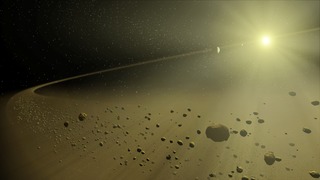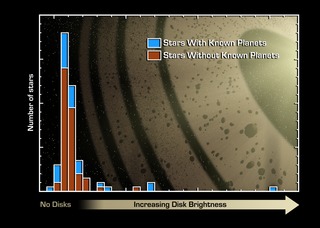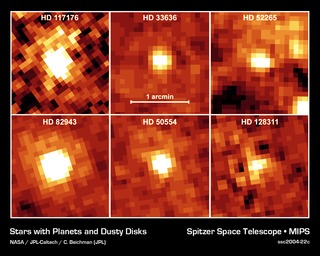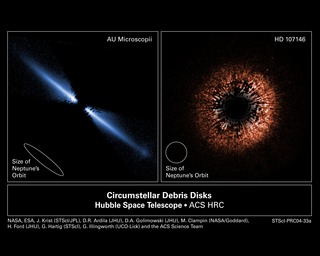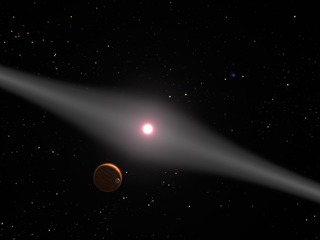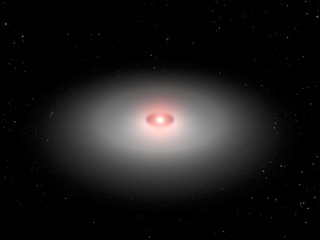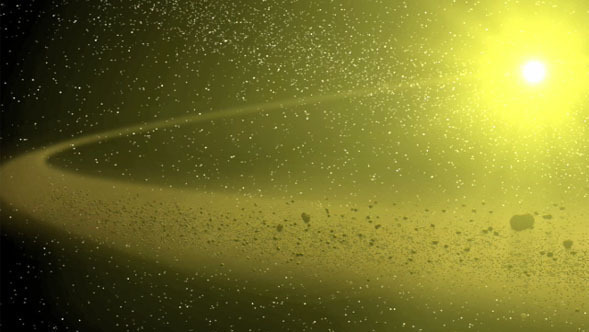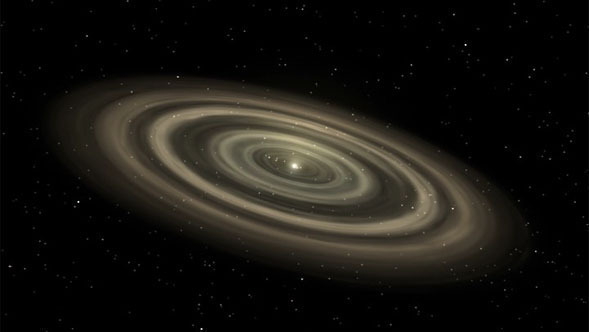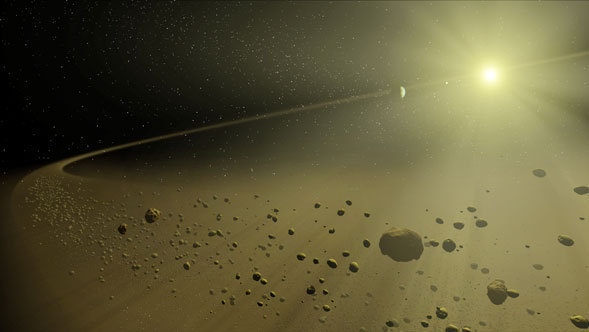
News Release • December 9th, 2004 • ssc2004-22 •
Two of NASA's Great Observatories, the Spitzer Space Telescope and the Hubble Space Telescope, have provided astronomers an unprecedented look at dusty planetary debris around stars the size of our Sun.
Spitzer has discovered for the first time dusty discs around mature, Sun-like stars known to have planets. Hubble captured the most detailed image ever of a brighter disc circling a much younger Sun-like star. The findings offer "snapshots" of the process by which our own solar system evolved, from its dusty and chaotic beginnings to its more settled present-day state.
"Young stars have huge reservoirs of planet-building materials, while older ones have only leftover piles of rubble. Hubble saw the reservoirs and Spitzer, the rubble," said Dr. Charles Beichman of NASA's Jet Propulsion Laboratory, Pasadena, Calif. He is lead author of the Spitzer study. "This demonstrates how the two telescopes complement each other," he added.
The young star observed by Hubble is 50 million to 250 million years old. This is old enough to theoretically have gas planets, but young enough that rocky planets like Earth may still be forming. The six older stars studied by Spitzer average 4 billion years old, nearly the same age as the Sun. They are known to have gas planets, and rocky planets may also be present. Prior to these findings, rings of planetary debris, or "debris discs," around stars the size of the Sun had rarely been observed, because they are fainter and more difficult to see than those around more massive stars.
"The new Hubble image gives us the best look so far at reflected light from a disc around a star the mass of the Sun," said Hubble study lead author, Dr. David Ardila of the Johns Hopkins University, Baltimore. "Basically, it shows one of the possible pasts of our own solar system," he said.
Debris discs around older stars the same size and age as our Sun, including those hosting known planets, are even harder to detect. These discs are 10 to 100 times thinner than the ones around young stars. Spitzer's highly sensitive infrared detectors were able to sense their warm glow for the first time.
"Spitzer has established the first direct link between planets and discs," Beichman said. "Now, we can study the relationship between the two." These studies will help future planet-hunting missions, including NASA's Terrestrial Planet Finder and the Space Interferometry Mission, predict which stars have planets. Finding and studying planets around other stars is a key goal of NASA's exploration mission.
Rocky planets arise out of large clouds of dust that envelop young stars. Dust particles collide and stick together until a planet eventually forms. Sometimes the accumulating bodies crash together and shatter. Debris from these collisions collects into giant doughnut-shaped discs, the centers of which may be carved out by orbiting planets. With time, the discs fade and a smaller, stable debris disc, like the comet-filled Kuiper Belt in our own solar system, is all that is left.
The debris disc imaged by Hubble surrounds the Sun-like star called HD 107146, located 88 light-years away. John Krist, a JPL astronomer, also used Hubble to capture another disc around a smaller star, a red dwarf called AU Microscopii, located 32 light-years away and only 12 million years old. The Hubble view reveals a gap in the disc, where planets may have swept up dust and cleared a path. The disc around HD 107146 also has an inner gap.
Beichman and his colleagues at JPL and the University of Arizona, Tucson, used Spitzer to scan 26 older Sun-like stars with known planets, and found six with Kuiper Belt-like debris discs. The stars range from 50 to 160 light-years away. Their discs are about 100 times fainter than those recently imaged by Hubble, and about 100 times brighter than the debris disc around the Sun. These discs are also punctuated by holes at their centers.
Both Hubble images were taken with the advanced camera for surveys. They will be published in the Astronomical Journal and the Astrophysical Journal Letters. The Spitzer observations are from the multiband imaging photometer and will appear in the Astrophysical Journal. Electronic images and additional information are available at: http://hubblesite.org/news/2004/33 and www.spitzer.caltech.edu .

